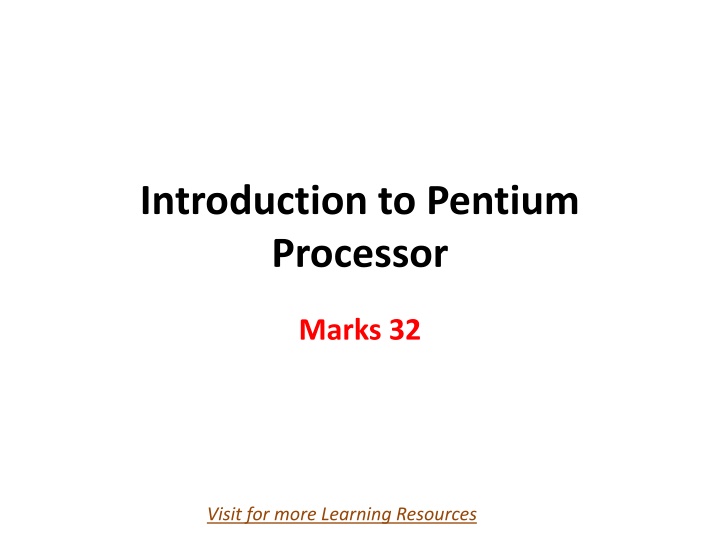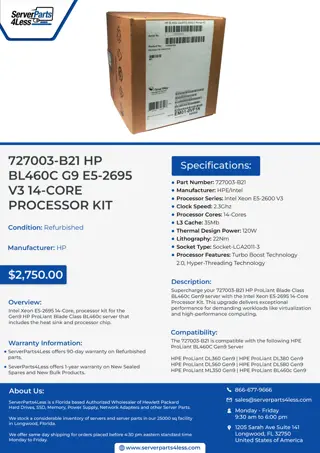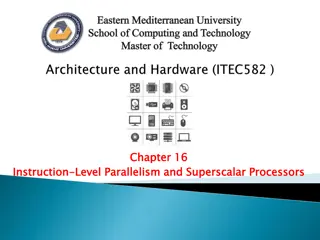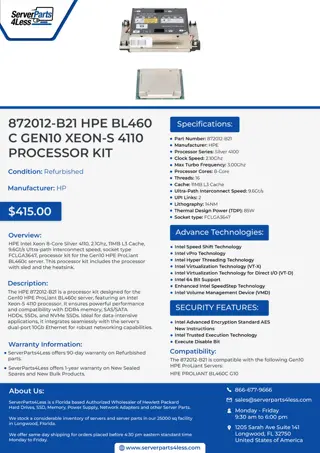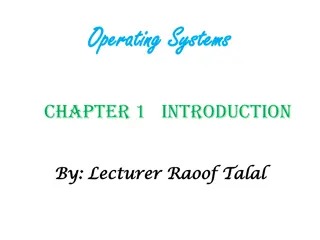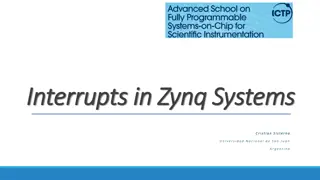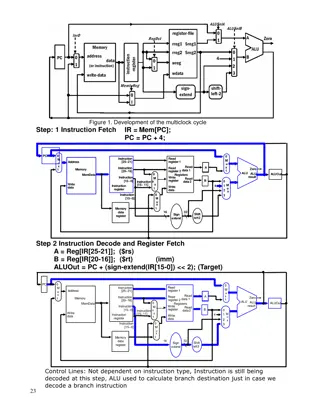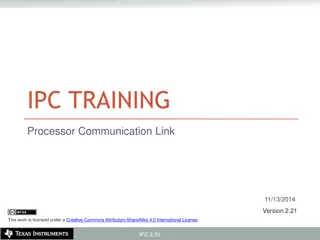In-Depth Look at Pentium Processor Features
Explore the advanced features of the Pentium processor, including separate instruction and data caches, dual integer pipelines, superscalar execution, support for multitasking, and more. Learn about its 32-bit architecture, power management capabilities, internal error detection features, and the efficient five-stage pipeline that enables parallel instruction execution. Dive into the details of this powerful CISC processor and understand its capabilities for high-performance computing.
Download Presentation

Please find below an Image/Link to download the presentation.
The content on the website is provided AS IS for your information and personal use only. It may not be sold, licensed, or shared on other websites without obtaining consent from the author.If you encounter any issues during the download, it is possible that the publisher has removed the file from their server.
You are allowed to download the files provided on this website for personal or commercial use, subject to the condition that they are used lawfully. All files are the property of their respective owners.
The content on the website is provided AS IS for your information and personal use only. It may not be sold, licensed, or shared on other websites without obtaining consent from the author.
E N D
Presentation Transcript
Introduction to Pentium Processor Marks 32 Visit for more Learning Resources Visit for more Learning Resources
Features of Pentium Processor Separate instruction and Data caches. Dual integer pipelines i.e. U-pipeline and V- Pipeline. Branch prediction using the branch target buffer (BTB). Pipeliened floating point unit. 64- bit external data bus. Even-parity checking is implemented for data bus, caches and TLBs.
Salient Features 32- architecture CISC processor. 32-bit address bus can address up to 4GB of physical memory. 64- bit data bus so arithmetic and logical operation can be perform on 64-bit operand. Two integer pipeline U and V with two ALU s provide one-clock execution for core instructions which Improved Instructions to execute Time. bit Superscalar and super-pipelined
Support five stage pipeline enables multiple instructions to execute in parallel with high efficiency. Two 8 KB caches memories, one for data and other for code. On- chip pipelined floating point coprocessor. Support power management feature i.e. System Management mode and Clock Control. Enhanced branch prediction buffer. On-chip memory management unit. Support multiprogramming and multitasking.
Internal error Detection features. 4MB pages for increased TLB Hit Rate. Support for Second level cache and Write Back MESI. Protocol in the data cache. Supports Bus cycle Pipelining, Address Parity and Internal Parity Checking, Functional Redundancy checking, Execution Tracing, Performance Monitoring.
Superscalar Execution It supports superscalar pipeline architecture. The Pentium processor sends two instructions in parallel to the two independent integer pipeline known as U and V pipelines for execution of multiple concurrently. Thus, processor capable of parallel instruction execution of multiple instructions is known as Superscalar Machine. instructions
Each of these pipeline i.e. U and V, has 65 stages of execution i.e. Prefetch First Decode Second Decode Execute Write Back
1. Pre-fetch (PF): In this stage, instructions are prefetched by prefetch buffer through U and V pipelene from the on-chip instruction cache. 2. First Decode (D1): In this stage, two decoders decode the instructions to generate a control word and try to pair them together so they can run in parallel. 3. Second Decode (D2): In this stage, the CPU decodes the control word and calculates the address of memory operand.
4. Execute (EX): The instruction is executrd in ALU and data cache is accessed at this stage. For both ALU and data cache access requires more than one clock. 5. Write Back (WB): In this stage, the CPU stores result and update the flags.
Separate Code and Data Caches: Pentium has two separate 8KB caches for code and data as the superscalar design and branch prediction need more bandwidth than a unified cache. The data cache has a dedicated TLB to translate linear address into physical address used by data cache. The code cache is responsible for getting raw instructions into execution unis of the Pentium processor and hence instructions are fetched from the code cache.
Advantages of having Separate Code and Data Caches Separate caches efficiently execute the branch prediction. Caches raise system performance i.e. an internal read request is performed more quickly than a bus cycle to memory. Separate caches also reduce the processor s use of the external bus when the same location are accessed multiple times. Separate caches for instructions a and data allow simultaneous cache look-up. Up to two data references and up to 32 bytes of raw op-codes can be accessed In one clock.
Branch Prediction Branch prediction is used to predict the most likely set of instruction to be executed and prefetch to make them available to the pipeline as and when they are called. Hence the pentium processor incorporate a branch target buffer (BTB), which is an associative memory used to improve the performance if it takes the branch instrction. Branch instructions of pentium processor change the normal sequential control flow of the program execution and may stall the pipelined execution in the pentium system.
Branches instruction is of two types i.e. conditional and unconditional branch. During the conditional branching, the CPU has two wait till the execution stage to determine whether the condition is satisfied or not. When the condition satisfies, a branching is to be taken using branch prediction algorithm for speed up of the instruction execution. In pentium Processor, BTB can have 256 entries which contains the branch target address for previously executed branches. The BTB is four ways set associative on-chip memory.
Whenever the branching occurs, the CPU checks the branch instruction address and the destination address in the BTB. When the instruction is decoded, the CPU searches the branch target buffer to decide whether any entry exists for a corresponding branch instruction. If BTB is hit, i.e. if BTB exist such entries, then the CPU use the history to decide whether the branch will be taken or not. If the entry exist in its previous history in BTB to take the branch, the CPU fetches the instruction from the target address and decodes them. If the branch prediction is correct, the process continue else the CPU clears the pipeline and fetches from the appropriate target address.
Floating point Unit The Pentium contains an on chip floating point unit that provides significant floating point performance advantage generations of processors. Providing the coprocessor onto the same chip as the processor, pentium allows faster communication and quicker execution. Thus many floating point instructions requires fewer clock cycles that the previous 80X87. over previous
Floating Point Pipeline The floating point pipeline of Pentium consists of eight stages which are used to speedup the execution of floating point unit. Hence, it is necessary floating point pipeline. These are prefetch, first decode, second decode, operand fetch, first execute, second execute, write float and error reporting. Floating point unit has eight stage pipeline which gives a single cycle execution for many of floating point instructions such as floating adds, subtract, multiply and compare
The stages and their functions are given below: 1. PF: Instructions are prefetched from the on chip instruction cache. 2. D1: Instruction decode to generate control word. A single control word causes direct execution of an instruction and complex instruction require sequence. 3. D2: Address of memory resident operand are calculated. 4. Ex: In this stage, register read, memory read or memory write operation is performed to access an operand as required by the instructioin. micro-coded control
5. X1: In this stage, the floating point data from register or memory is written into floating point register or memory is written into floating point register and converted to floating point format before loaded into the floating point unit. 6. X2: In this stage, the floating point operation is performed by floating point unit. 7. WF: In this stage, results or floating point operation are rounded and the written to the destination floating point register. 8. ER: In this stage, if any error is occurred during floating point execution, then it is reported and FPU status word is updated.
Floating point Exception There are six floating point exception condition while execution floating point instructions are available in status word register of Pentium FPU. These exceptions are: 1. Invalid Opeartions: Stack overflow or underflow Invalid arithmatic operation This exception occurs when stack fault flag (SF) of the FPU status word indicates the type of operation i.e. stack overflow or Underflow for SF=1 and an arithmetic instruction has encountered an invalid operand for SF=1.
Divide by zero: This exception occurs wheneveran instruction attempts to divid a finite non-zero operand by 0. De-normalized operand exception: The de-normal operand exception occurs if an arithmetic instruction attempts to operate on a de-normal operand or if an attempt is made to load de-normal single or double real value into an FPU register. Numeric flow exception: This exception occurs whenever the rounded result of an arithmetic instruction is less than the smallest possible normalized, finite value that will fit into the real format of the destination operand. Inexact result (Precision) Exception: This exception occurs if the result of an operation is not exactly representable in the destination format.
Comparison of 80386 and Pentium 80386 Pentium 32- bit integer core CPU with 32 bit Data bus 32 bit CPU with 64-bit data bus No superscalar architecture and single cycle execution Superscalar architecture i.e. two pipelined Integer Units are capable of 2 Instructions per clock Ni internal cache available for data and code Separate 8KB code and 8KB data cache available 80386 does not support branch prediction Advanced design feature i.e. Dynamic branch Prediction One integer Alu Two integer ALU Operating frequency are 20 MHz to 66 MHz Operating frequency 60 MHz and more FPU is non- pipelined as it is an external device 80387 FPU is pipelined as it is in built in pentium
Pentium Pro Features The Pentium pro has a performance near about 50% higher than a Pentium of the same clock speed. Super-pipelining: 14 stages pipelining as compare to 5 stage of pentium Processor. Integrated Level 2 Cache: 256-KB static Ram on- chip coupled to the core processor through a full clock speed, 64- bit, cache bus. 32- bit Optimization: Optimized for running, 32-bit code used in Windows NT. Wider Address Bus: 36 bit address bus which is used to address 236=64GB of physical address space.
Greater Multiprocessing: Multi-processor systems of up to 4 Pentium Pro processors. Out of order completion: Out of order execution mechanism called as dynamic execution. Superior branch prediction Unit: The branch target buffer (BTB) is double the size as compare to Pentium processor which increases its accuracy. Register renaming: Improves parallel performance of the pipelines. Speculative execution: Speculative execution reduces pipeline stall time in its RISC core. Dynamic data flow analysis: Real time analysis of the flow of data trough the processor to determine data and register dependencies and to detect opportunities for out of order instruction execution. For more detail contact us For more detail contact us
